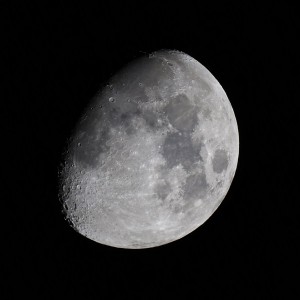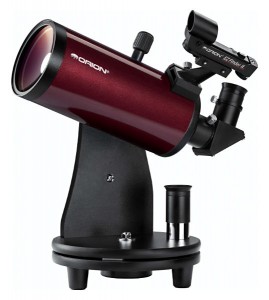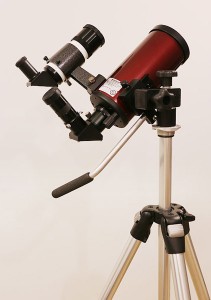During the Summer of 2013 I started learning the constellations and viewing the night sky from my back yard with a pair of 8×40 binoculars. While these show many more stars than can be seen by eye and are great for viewing wide fields, I quickly became interested in closer views of the Moon, planets, and brighter deep sky objects, and began looking for a small telescope.
I wasn’t sure how much use a telescope would see and I didn’t want to dedicate space to a large one so I was drawn to Maksutov-Cassegrain telescopes, which are among the most compact designs, have a reputation for excellent optical performance, and are well suited to viewing the kinds of subjects I was interested in observing.
I found that the Orion StarMax 90mm (that’s the Orion link, here it is at Amazon) and Celestron C90 (B&H, Amazon) both had many good reviews and seemed to offer great value. They are both made by Synta Optical and use a very similar Optical Tube Assembly (OTA). The main reason I preferred the StarMax was that the included accessories seemed more useful for looking at the sky than those that come with the C90, which is configured as a terrestrial spotting scope.
So in late September of 2013, I purchased the Orion StarMax 90mm Mak as my first telescope. What follows are my impressions from using the telescope over the past year and a half.
Sizing Up the StarMax
With an OTA that is only 11″ long the StarMax 90mm is truly small. The scope is easy to assemble: attach the tube to the mount, the mirror diagonal to the back of the tube, slip an eyepiece into the diagonal, and slide the finder into its mount.
The included mount is very similar to that provided with the Celestron FirstScope and is essentially a scaled down version of the AWB OneSky’s mount. It provides adequate support for the scope and allows smooth movement in both directions.
The underside of the base has an adapter with a 3/8″ socket (a 1/4″-20 reducer is also included) and can either be attached to a photo tripod or placed on a sturdy table or stool. With the base mounted to a Bogen 3001 tripod dampening times at powers over 100x were less than 2 seconds with the legs fully extended. If you don’t have a sturdy photo tripod David Fuller’s tripod design would work well with the 90mm StarMax.
The StarMax OTA has a short Vixen-style dovetail so the scope is easily removed from the supplied mount and can be used on many mounts with compatible saddles. These days I use the 90mm Mak almost solely with the Universal Astronomics DwarfStar mount. The tube’s dovetail mount also has 1/4″-20 threaded holes allowing it to be mounted directly to a photo tripod head if desired.
The Orion 90mm Mak under the Stars
When I first received the scope I assembled it indoors and pointed it out a window; a big mistake. The image was horrible and made me wonder if the scope was defective, but I decided to see if it did better outside at night. It turns out that window glass produces all kinds of distortions and problems in the image. I’m sure this would’ve been obvious to anyone familiar with telescopes but as a novice I hadn’t considered it. The views of the moon that night were incredible and worth the price of the scope.

Waxing Gibbous Moon taken with a DSLR using the StarMax 90mm Mak as a camera lens on November 12, 2013.
The included eyepieces are Plossls of good quality and will get you started viewing the Moon and planets. The entire moon fits in the view of the 25mm (50x) eyepiece and the 10mm (125x) eyepiece provides plenty of magnification to see Jupiter’s cloud bands and moons and Saturn’s rings.
Adding a wider 32mm (39x) eyepiece can be useful for viewing larger open clusters like the Pleiades, though the entire cluster cannot fit into the StarMax’s maximum field of view of 1.3º.
Orion lists the scope’s useful magnification limit as 180x but a 6.4mm (195x) eyepiece can be worth using under very clear viewing conditions. If the seeing supports this magnification the 90mm Mak’s optics are certainly up to the task. I recently had it up to ~200x on the Moon and during periods of steady seeing the image was strikingly sharp. I believe the little Mak would hold up at even higher magnifications on the Moon and double stars as there is enough light when viewing these objects.
The red dot finder is easy to use and once aligned, can be accurate enough to find objects with the 10mm eyepiece, provided they are bright enough to see with the naked eye. As a beginner looking for views of the moon, planets, and brighter Messiers this wasn’t much of a limitation. Once I started trying to star hop to fainter subjects a magnified finder became desirable. The StarMax has a standard Synta type finder shoe and a 6×30 or 9×50 RACI finderscope makes navigating to these objects much easier.
A 90mm Mak for Daytime and Photo Use
The scope also works well as a daytime spotting scope and its relatively close focus capability makes it useful for watching birds and wildlife. Buying a lower magnification eyepiece like a 32mm Plossl is recommended because the Mak’s long focal length gives it a high magnification and a narrow field of view. I’ve since come to prefer the wider views offered by short focal length refractors for daytime use.
Removing the diagonal reveals threads that allow an SLR to be attached using an inexpensive T-mount adapter turning the scope into a 1250mm f/13.9 lens, which can be difficult to focus accurately but capable of impressive detail. The easiest way I’ve found to achieve best focus is to use a digital SLR with magnified live view.
Is a 90mm Mak the Best Telescope for Me?
The Orion StarMax 90mm provides impressive views of the Moon and planets. It complements wide field binocular viewing very well and provides a good deal of enjoyment for the money spent. Its usefulness as a spotting scope and ability to easily attach a camera are icing on the cake.
The scope’s small size is a big advantage and allows it to easily be picked up and moved around the yard to get a clear view of different areas of the sky. Traveling with or storing the scope is a breeze. The 11″ long OTA fits snugly inside a small photo backpack and there is plenty of room for the included (and additional) eyepieces, finder, and diagonal.
If you can deal with something a bit larger, the AWB OneSky costs about $200. With a 32mm Plossl it will fit the Pleiades in a single field of view, something the Mak can’t do. With its 130mm of aperture it will also give brighter, more detailed views at high powers on the planets and the Moon. It is a bigger telescope but still relatively compact and can be used for travel.
If you are able to spend significantly more on a telescope, a good 80mm f/6 triplet refractor will out perform the 90mm Mak across the board while being not much bigger in size or weight. It will be capable of much wider fields of view (up to 5.6º with a Super Wide Angle 2″ eyepiece), gather more light, and provide higher contrast views.
A recent comparison of my 90mm Mak and 80mm triplet refractor on the Moon at ~200x made the increased brightness and contrast of the refractor apparent to me. The StarMax is a very good Lunar scope but one feature on the northern rim of Copernicus that was readily visible in the 80mm only showed in the 90mm Mak during brief periods of very good seeing. Here the extra contrast of the 80mm was the key.
The price of this extra performance is steep and you are generally looking at spending about 3x the cost of the StarMax. And of course in that price range, if you can manage a significantly larger telescope, it’s easy to find examples that will show much more such as the proverbial 8″ Dobsonian.
So the combination of optical quality, cost, and very small size are the strengths of the StarMax and other 90mm Maks. If you are looking for a telescope that meets these criteria then this could be your scope. Keep in mind though if you can compromise on one of these you can get a more versatile or better performing scope.
-Dave
Original content copyright 2015 by David Philips. All Rights Reserved. This post may contain links to affiliate sites; sales through affiliate links may benefit this site.


Hi,
I am wanting to purchase a portable scope to view the moon and planets and the occasional comet. Looking at the Pleiades and such objects would be great, too.
I sold my 10 inch Dobsonian because it was too big to use.
I have about $300. I am looking for portability. What would you recommend?
Thanks!
Michael, the StarMax is certainly an extremely portable scope and very good on the Moon but its high focal length and narrow maximum field of view means you can’t fit all of the Pleiades in the eyepiece. With your budget and goals I think it’d be hard to beat the AWB OneSky. The scope itself is $200 leaving you with funds to add some additional eyepieces, and maybe a RACI finder. For eyepieces I’d recommend a 32mm Plossl, which will give a fantastic view of the Pleiades. You’ll also want a way to reach higher magnifications for planets and the Moon – I tend to use a Barlow and 8mm. Be sure to check out the article on optimizing the OneSky.
I know this is an older article but maybe you’re still around for input. I’m looking at using this scope for portable viewing of the moon/planets on trips to the mountains. My biggest idea is to use it with my DSLR. It is a Sony e-mount camera but I’m confused on which adapter to get for this scope? I intend to get a barlow as well for the telescope so if you could possibly direct me to the correct size that would be great.
Thanks,
Daniel
Daniel,
The StarMax uses 1.25″ eyepieces and any 1.25″ Barlow will work for visual use. I like the Baader 2.25x Q-barlow for its size and image quality and the fact that the element can be threaded directly to an eyepiece to give 1.3x magnification – it’s like having two Barlows in one.
To attach your DSLR you want a T2 adapter for your camera mount. If you have a Sony e-mount this adapter should work but you may want to check the reviews for your specific camera.
Hi thanks for this review!
I’m looking at purchasing my first telescope. I’m interested in viewing the usual moon and planets but I would also like to be able to view some DSOs. I’m considering a 90mm Mak. Since it is a smaller Aperture Mak, I understand there will be limitations as to DSOs that can be seen especially in my light polluted city viewing. But just so I get an idea, what DSOs have you been able to view in this 90mm Mak?
Thanks!
Cherry, my comparisons have shown that the StarMax is roughly equivalent to a 70mm refractor in terms of light gathering and object brightness. Some example of objects that have shown well in the scope are:
Galaxies – M31, M81, M82
Supernova – SN 2014J
Diffuse Nebula – M42
Planetary Nebula – M57
Open clusters – Double Cluster (NGC 869 and 884), M11
While a great many DSOs can be viewed with the StarMax, if observing DSOs is a primary interest I think you would be better served by the AWB OneSky. The cost is very similar, though the OneSky is a larger telescope, but it will provide brighter more detailed views of every subject.
Dear Sir, I have a 90 Starmax Cassegrain and I was wondering why I could not take the whole photo on my iPhone! The photo would not fit into my eyepiece no matter what, but I got excellent close ups! I believe this scope is for Deep sky objects.
Diane Beckett, Pennsylvania
(Clear skies)
Hi Diane,
The Starmax 90 has a relatively long focal length that, while helpful for viewing things like the Moon and planets, can make it harder to get wider fields of view. The Starmax comes with a 25mm Plossl eyepiece that will give a magnification of 50x and a field of view of roughly 1º (for reference the apparent size of the full moon is about 1/2º). Some larger objects such as the Double Cluster benfit from a lower magnification and a wider field of view and adding a 32mm Plossl, which gives 39x and 1.3º, can be useful. The lower magnification and wider field of a 32mm Plossl is also helpful if you want to use the Starmax as a spotting scope for birds and such.